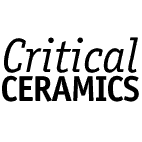Click to find out more...
Show your support by visiting our sponsor...



Ceramic Millennium 99 — Workshop 's-Hertogenbosch
The dematerialization of information and its carriers is steadily increasing as information technology continues to develop. Technology is becoming less and less visible, with devices turning into ‘black boxes’ that require little or no physical effort on the part of the user to operate. ‘High tech’ has come to mean ‘low touch’ and, increasingly, ‘no touch’.
Following on from earlier processes of demythologization and secularization, could it be that we have now entered a period of ‘dephysicalization’? And what repercussions might this have for design and art and the way they are received? What are the cultural implications if matter becomes superfluous or is reduced to the smallest possible function, and if the body is no longer required to make more than the barest effort?
Yet, a countermovement has sprung up even while this dematerialization is in full swing. We seemingly have a deep-seated need to express ourselves through, and to identify with, material culture. The inability to do so, combined with a psychological resistance towards the neutral, anonymous, cold, and simultaneously invisible and incomprehensible functions of high-tech equipment, merely intensifies our need for objects that can be held, cherished, and admired — objects, in short, with which we can ‘have a relationship’. While digital gadgets have penetrated every aspect of our living and working environment, from payment transactions to food processing, traffic and leisure, security to information, culminating in the Tamagotchi — a high-tech surrogate for the human caring instinct — designers and artists have been responding to our human need for matter as the concrete form through which to satisfy our aesthetic, tactile, symbolic, fetishistic, and psychological needs.
As IT [Information Technology] has developed, intensive research has been carried out into materials, their molecular properties, and potential applications. Clay is no exception. Scientific research and experiments have refined clay applications to such a degree that they form a vital element in many highly advanced industries.
The influence between high-tech developments on one hand and art and design on the other is not, of course, one way or straightforwardly causal. Art (to which we will restrict ourselves) also has its own parallel, autonomous development. There is evidence here, too, of increasing dematerialization. In the first place, we have the emphasis on the idea in the mid-1960’'s, culminating in the conceptual art of people like Sol Lewitt, Joseph Kosuth, On Kawara, and Stanley Brown. And then there is the interesting use of media like light, photography, film, video, and the computer that produces or conveys intangible images.
These developments cannot go unnoticed by the ceramics disciplines. Their precise implications for ceramics form the central issue to be tackled by the teachers and students taking part in the workshop — an issue that will increasingly confront the professional practice of (clay) artists, now and in the future.
After all, even in a digital era, artists are faced with the task of giving material form to their thoughts, intuitions, and ideas. Clay — along with the other physical materials — remains an ideal medium for this, whenever justified by concept. What might be the positive or negative significance of digitalization or dematerialization to artists working with a ‘natural’ and solid material like clay? Does digitalization provide stimulus for artistic concepts that are executed in clay? Does ceramics have something to say to digitalization or do the two worlds remain separate? Will ceramics become less physical, ‘lighter’ in the high-tech era? Or is it a medium par excellence that will keep both feet firmly on the ground and that meets the unchanging human need for self-expression in material form — perhaps now more than ever?
Although these questions require reflection, they will have to be solved primarily through the practice of art. Photography, film, video, computers, and many other technological advanced have each been held up at one time or other as a threat to traditional artistic disciplines. Although they have certainly influenced one another, all media are now used alongside and in conjunction with one another, depending on the idea to be expressed. Peaceful coexistence of this kind seems enough right now, but the likelihood of a fully digitized culture will have more far reaching consequences for art and the way it is received.
